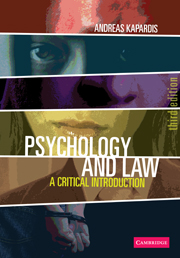Book contents
- Frontmatter
- Contents
- List of case studies
- Acknowledgements
- Foreword
- 1 Psycholegal Research: An Introduction
- 2 Eyewitnesses: Key Issues and Event Characteristics
- 3 Eyewitnesses: The Perpetrator and Interviewing
- 4 Children as Witnesses
- 5 The Jury
- 6 Sentencing as a Human Process, Victims, and Restorative Justice
- 7 The Psychologists as Expert Witnesses
- 8 Detecting Deception
- 9 Witness Recognition Procedures
- 10 Psychology and the Police
- 11 Conclusions
- Notes
- References
- Index
6 - Sentencing as a Human Process, Victims, and Restorative Justice
- Frontmatter
- Contents
- List of case studies
- Acknowledgements
- Foreword
- 1 Psycholegal Research: An Introduction
- 2 Eyewitnesses: Key Issues and Event Characteristics
- 3 Eyewitnesses: The Perpetrator and Interviewing
- 4 Children as Witnesses
- 5 The Jury
- 6 Sentencing as a Human Process, Victims, and Restorative Justice
- 7 The Psychologists as Expert Witnesses
- 8 Detecting Deception
- 9 Witness Recognition Procedures
- 10 Psychology and the Police
- 11 Conclusions
- Notes
- References
- Index
Summary
It is a reality in law that the Constitution of the United States protects the right of suspects and defendants but not the right of victims.
(Bartol and Bartol, 2004b:194)Sentencing cannot be an exact science; indeed, Lady Wootton likened the sentencer to a small boy adding up his sums but with no one to correct his answer.
(His Honour Judge P.K. Cooke, OBE, 1987:57)Most judges do not read psychology journals or scholarly books; some do not even read law reviews.
(Wrightsman, 1999:viii)The era of a restorative justice paradigm as a fully-fledged alternative to both rehabilitative and retributive approaches remains very distant.
(Weitenkamp, 2002:326)INTRODUCTION
Crime and punishment has always been a topic of great interest. The quotes provided reflect some of the controversies surrounding sentencing in contemporary western societies. Judges have been termed ‘the gatekeepers of the legal system’ (Wrightsman, 1999:vii). Since the 1970s the judiciary in western countries has undergone unprecedented expansion in both its size and power. The expanding judicial role is evident in the appointment, training and scrutiny of members of the judiciary (Malleson, 1999). At the same time there has been increasing tension between the requirement of judicial independence and accountability created by the changes that have taken place. The reader should note in this context that, as the experience in the UK since the 1990s shows, the growing politicisation of sentencing policy ‘threatens to marginalize principled and empirically based arguments about sentencing’ (Ashworth, 2007:99).
- Type
- Chapter
- Information
- Psychology and LawA Critical Introduction, pp. 195 - 228Publisher: Cambridge University PressPrint publication year: 2009



